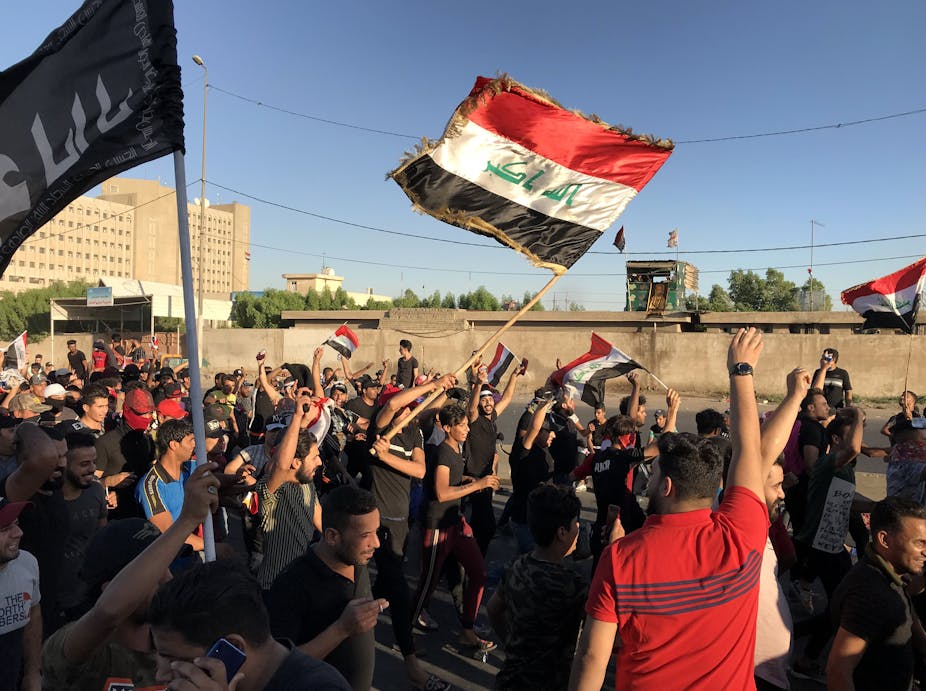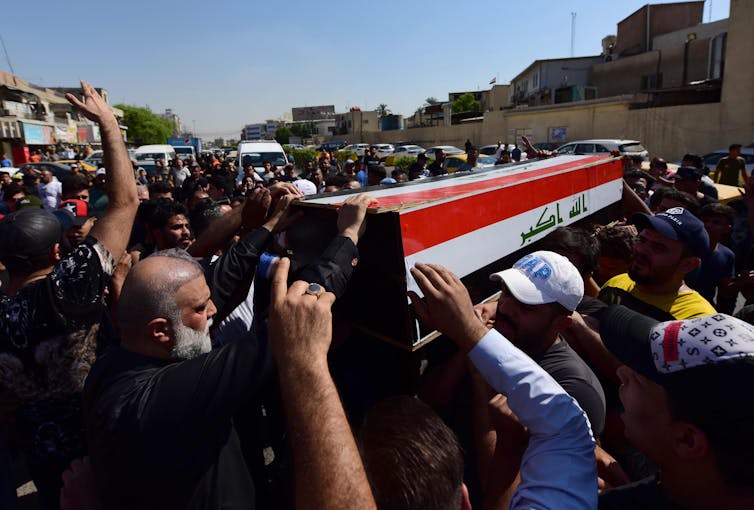When Muhanad Habib, a 22-year-old Iraqi from the Sadr City district of Baghdad, posted on Facebook in late September, he probably didn’t imagine that his demands for a better life and basic rights would be met with bullets.

Anger on the streets: protesters in al-Tayaran square in central Baghdad on October 4. Murtaja Lateef/EPA
It will be a huge and angry public revolution in Baghdad … We will take to the streets protesting … Enough silence about what’s going on in Iraq. We cannot just watch Iraq being destroyed when we have armies of jobless and poor.
This was how it all started. Angry youth from Baghdad took to the streets. Unaffiliated with any political party or with well-known activists, the protesters – the majority of whom were born in the late 1990s or early 2000s – despaired about any prospect for change in Iraq.
The crackdown by security forces that followed left more than 100 people dead and thousands more injured. Iraqi president Barham Salih condemned the crackdown in a televised speech on October 7, claiming that orders to shoot at the protesters weren’t made by the state or its apparatus. The interior ministry ordered an investigation into the deaths.
Yet, Salih’s statement raised questions about who is actually running the Iraqi state. And despite his and international condemnation, the crackdown continues on the ground.
Calls for a homeland
Endemic corruption, unemployment, flawed institutions and poor public services linger in Iraq and have prompted protests since 2011, including notably in Basra in 2018. The recapture of Iraqi lands from the grip of Islamic State (IS) gave many Iraqis hope that lessons would be learnt about the repeated failures which gave rise to IS, and that those in power would take sincere steps to reform. But that hope has been diminishing every day.
The most recent protests came in the wake of multiple smaller demonstrations by different groups, including PhD graduates, doctors and engineers in September 2019.
They followed government actions that caused widespread anger. Impoverished people were outraged at a recent state campaign to destroy unlicensed properties and market stalls across Iraq, leaving many homeless and jobless.
It also followed the removal of a key general, Abdul Wahab Al Saadi, from his position as commander of the Counter-Terrorism Service, followed by his demotion to a lower post at the Ministry of Defence. The marginalisation of a figure admired for his role in the military campaign against IS enraged many Iraqis.
The new generation want a homeland. “We want a respected homeland,” and “I am taking to the streets to get my right,” were among the slogans on display during the protests. “The issue is not about water or electricity, but about a homeland,” shouted another protester.
Violent crackdown
The immediate crackdown of the protests has surprised, shocked, and shaken Iraqis. The suppression turned a protest about anti-corruption and unemployment into an uprising against the status quo and what participants see as foreign interference, particularly from Iran.
Tear gas, live ammunition, and snipers were used to quell the protesters. As one protestor put it: “They did things to us they never did to IS. They beat and insulted us. They used live fire and grenades. What have we done? All what we are asking for are our rights and all people’s rights.” The protestor’s words were used as the opening of a new rap song titled “Iran’s tails” released in the wake of the crackdown by an Iraqi expat in solidarity with the demonstrators.

The funeral in Baghdad of a protester allegedly killed by Iraq soldiers. Murtaja Lateef/EPA
The violent oppression and state’s authoritarian measures to cover up the carnage are reminiscent of the days of Baathist rule and former president Saddam Hussein’s oppression of a 1991 uprising. In 2019, such measures included an internet blackout across Iraq except in the Kurdistan region, curfews in Baghdad and other provinces in the south, and blocked roads leading to Tahrir square in Baghdad where demonstrators gathered. Comparisons were also made with IS, who also cut off the internet in Mosul when Iraqi troops were advancing to retake the city in 2016.
Offices of media agencies covering the protests were attacked and reports emerged of protesters, activists and journalists being threatened and arrested.
By disconnecting Iraqis from the outside world, the authorities in Iraq tried to control the circulation of videos that showed civilians killed in broad daylight. But they also pushed the narrative of Iran-backed political parties and officials: that “intruders” – an implicit reference to Baathists or actors backed by an external agenda – were responsible for riots. A similar narrative was echoed by Iranian media outlets to undermine the legitimacy of the protests, accusing foreign powers of being behind them, an indirect reference to the US, Israel and Saudi Arabia.
Despite the internet blackout, which remains partially in place, footage of the live shooting at the protestors and ambulances carrying the wounded were shared on social media as some Iraqi protesters resorted to innovative methods with the help of Iraqi expats to reveal the scale of the violence.
The heartbreaking scenes caused uproar among the Iraqi diaspora who protested in several countries around the world in solidarity. But for people inside Iraq, many still don’t know the scale of the atrocities as they haven’t been able to access social media sites.
The fallacy of democracy
Since the fall of Hussein’s regime in 2003, successive governments have failed to put an end to Iraqis’ grievances. Time and again, only empty promises were made, and superficial measures taken. The electoral system has helped to produce and perpetuate a hybrid form of kleptocracy, authoritarianism and kakistocracy – a government run by the worst, or most unscrupulous people. Armed groups, tribes, foreign powers and religious clergy have all maintained this system.
The latest protests may have been suppressed but they revealed that democracy in Iraq is nothing but a facade. What sort of democratic government kills its own people, taking away their hopes and dreams? And can it still be called legitimate? Reacting indifferently to the deadly crackdown of innocent people in Iraq, the world needs to at least recognise that the root causes of Iraq’s ills are in the post-2003 system itself.
Courtesy: The Conversation


